#fossil reptile shell
Explore tagged Tumblr posts
Photo

RARE: Giant Turtle Shell Fossil – Large Section, Cretaceous, Australia
This listing offers a rare and substantial fossil section of a giant turtle shell, dating to the Cretaceous Period, and originating from Australia. This is a large carapace (shell) fragment, representing a prehistoric marine or freshwater turtle that lived during the age of the dinosaurs.
Fossil Type:
Specimen: Turtle Shell Fossil (Carapace Section)
Likely from a large cryptodiran turtle based on structural and regional indicators
Geological Context:
Period: Cretaceous
Estimated Age: ~100–66 million years ago (exact stage unspecified due to locality constraints)
Depositional Environment: Likely fluvial or marginal marine settings; turtles during this time inhabited both freshwater rivers and coastal marine lagoons
Preservation: Mineral replacement of original shell bone; stable and consolidated, with visible scute impressions or bone texture in many specimens
Morphological Features:
Broad, gently curved shell fragment from the carapace (top of the shell)
Possible preserved sutures between scutes (the bony plates of the shell)
Textured surface consistent with dermal ossifications of large Cretaceous turtles
Dense, heavy fossilised bone with natural weathering and coloration
Scientific Importance:
Turtle fossils from the Cretaceous of Australia are rare and often fragmentary, making this large, intact section particularly desirable for collectors or research reference
Contributes to the understanding of turtle diversity in Gondwanan continents during the Mesozoic era
May be associated with genera such as Notochelone, Bouliachelys, or other large extinct marine cryptodires depending on region
Locality Information:
Australia – Specific site undisclosed, but Cretaceous turtle remains are known from deposits in Queensland and New South Wales, especially in areas formerly covered by inland seas and floodplains
Authenticity & Display:
All of our fossils are 100% Genuine Specimens and are supplied with a Certificate of Authenticity. The photographs in the listing show the actual fossil specimen you will receive. Please refer to the image for full sizing, with the scale cube = 1cm.
This is a rare opportunity to acquire a genuine, large fragment of a Cretaceous turtle shell from Australia. Perfect for fossil collectors, vertebrate palaeontology enthusiasts, or natural history displays.
Add a striking and scientifically valuable fossil to your collection—an authentic relic of the ancient Cretaceous ecosystems of prehistoric Australia.
#Giant turtle shell fossil#Cretaceous turtle fossil#Australian fossil turtle#fossil carapace section#rare turtle fossil for sale#large turtle shell bone#prehistoric turtle fossil Australia#certified fossil turtle#fossil reptile shell#authentic turtle fossil specimen
1 note
·
View note
Text

Act like Megalochelys atlas and smile, because it’s Fossil Friday! One of the largest known land turtles, scientists think this massive reptile could reach heights of 5.9 ft (1.8 m)—tall enough to look a grown human in the eye. This specimen’s shell measures some 7.4 ft (2.3 m) long and in life, it may have weighed more than 2,000 lbs (907 kg). Megalochelys lived during the Late Pliocene about 2 million years ago. The fossil on display in the Museum’s Hall of Vertebrate Origins was found in 1922 in Chandigarh, India.
Photo: © AMNH
2K notes
·
View notes
Text
#2829 - Psephophorus terryprachetti - Pterry's Giant Pturtle

A very large, extinct, leatherback turtle from the Eocene, named after beloved author Terry Pratchett. He was pleased about this, saying that anybody that wasn't delighted about getting a species named after them was clearly a Pod being from the Planet Zog.
The first fossils from the genus were discovered by German Paleontologist Christian Erich Hermann von Meyer in 1846, but all he had were the dermal plates (not that different from the fossil above, really). That's probably why even by 1879, they still weren't clear on what it actually was - British paleotologist Harry Govier Seeley thought they resembled the armour of an armadillo.
The Pturtle was discovered in New Zealand in the 1990s. It would have been 2.5m long, in life.
Sadly, there's only one Dermochelyid turtle left in the world - the Leatherback Dermochelys coriacea, which is critically endangered in some areas. Leatherbacks are unique compared to other modern sea turtles because they lack a bony shell; instead, its carapace is covered by oily flesh and flexible, leathery skin. They're also the deepest-diving and fastest reptiles in the world, swimming down to over 1200m depth, at speeds of up to 35kph. Their constant activity and internal adaptations lets them run at a surprisingly high internal temperature - 18C above the surrounding water.
The biggest threat to leatherback survival is, unfortunately, humanity - hatchlings can be confused by artificial light and head inland instead of towards the water, older turtles are easily caught in fishing nets, and they can confuse plastic bags floating in the water for the jellyfish that form the bulk of their diet.
Otago Museum, Dunedin, Aotearoa New Zealand.
#Otago Museum#Dunedin#Dermochelyidae#Psephophorus#leatherback turtle#new zealand fossil#fossil turtle#terry pratchett#great a'tuin
210 notes
·
View notes
Text
Round 3 - Mammalia - Monotremata




(Sources - 1, 2, 3, 4)
Our first and most ancient living order of mammals is Monotremata. There are five living species of monotreme: one Platypus (image 1) and four echidnas. These are the Short-beaked Echidna (Tachyglossus aculeatus) (gif below), Attenborough’s Long-beaked Echidna (Zaglossus attenboroughi) (image 4), the Western Long-beaked Echidna (Zaglossus bruijnii) (image 2), and the Eastern Long Beaked Echidna (Zaglossus bartoni) (image 3).
Monotremes have structural differences in their brains, jaws, digestive tract, reproductive tract, and other body parts, compared to many other mammals, though they are most often differentiated by the fact that they are the last remaining order of mammals to lay eggs. All living species lack teeth as adults, though platypuses have them as babies. All living species have spurs on their hind limbs, though they are vestigial in echidnas. In male platypuses they are attached to venom glands and contain venom powerful enough to kill predators as large as a dog. Monotremes have 400-40,000 electroreceptors on their snouts, depending on species, which they use to locate invertebrate prey buried beneath sediment. All living species of monotremes are indigenous to Australia and New Guinea, though Cretaceous species were also found in South America.
Monotremes possess five pairs of sex chromosomes and one of the X chromosomes resembles the Z chromosome of birds, suggesting that the two sex chromosomes of other mammals evolved after the split from the monotreme lineage. Like reptiles, monotremes have a cloaca, which is a single opening for both reproduction and waste removal. However, urine is excreted through the cloaca while semen passes through the male monotreme’s penis. The monotreme penis is similar to that of turtles and is covered by a preputial sac. Monotreme eggs are soft-shelled and leathery. They are retained for some time within the mother and receive nutrients directly from her, generally hatching within ten days after being laid. Newly hatched monotremes are called “puggles,” and are fetus-like, with relatively well-developed forelimbs that enable them to crawl around. Female monotremes do have mammary glands and nurse their young with milk, though they lack teats. Instead, mother monotremes lactate via pores in their skin, “sweating” out the milk. All five living species show prolonged parental care of their young, with low rates of reproduction and relatively long life-spans.
Monotremes arose in the Early Cretaceous. Some of the oldest known platypus-like fossils are Steropodon and Dharragarra of the Late Cretaceous. Our living platypus is also known from Pliocene fossils.
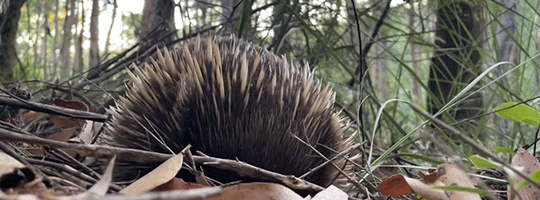
Propaganda under the cut:
Monotremes maintain a lower average temperature than most mammals, conserving energy by "switching off" their temperature regulation and going dormant in cold weather.
The tongues of long-beaked echidnas (genus Zaglossus) have sharp, tiny spines that help them capture their termite, ant, and worm prey. Since they have no teeth, they break down their food by grinding it between the bottoms of their mouths and their tongues.
Monotreme milk contains a highly expressed antibacterial protein not found in other mammals.
Monotremes are the only mammals (apart from the Guiana Dolphin [Sotalia guianensis]) known to have a sense of electroreception, and the Platypus's electroreception is the most sensitive of any monotreme.
In the American animated series Phineas and Ferb, the title characters own a pet bluish-green Platypus named Perry who, unknown to them, is a secret agent. Coincidentally, and unbeknownst to show creator Dan Povenmire at the time, real platypuses biofluoresce a similar cyan colour when seen under ultraviolet lighting!
The longest recorded lifespan for an echidna in human care was 50 years, with anecdotal accounts of wild individuals reaching 45 years.
Venom production rises among male Platypuses during the breeding season, and it may be used to assert dominance.
I’m really sorry about more penis talk but we’re all adults here I hope. So… male echidnas have a four-headed penis, covered in penile spines. During mating, the heads on one side "shut down" and do not grow in size; the other two are used to release semen into the female's two-branched reproductive tract. Each time it copulates, it alternates heads in sets of two. When not in use, the penis is retracted inside a preputial sac in the cloaca. During mating season, a female may be followed by a line or "train" of up to ten males, the youngest trailing last, with some males switching between lines.
In 1799, the first scientists to examine a preserved Platypus body deemed it a hoax made of several animals sewn together.
Echidnas are very timid. When frightened, they attempt to partially bury themselves and curl into a ball similar to a hedgehog. Strong front arms allow echidnas to dig in and hold fast against a predator pulling them from the hole.
The rarest species of monotreme is the critically endangered Attenborough's Long-beaked Echidna (Zaglossus attenboroughi). It had only been seen once in 1961 in the Cyclops Mountains of the Indonesian province of Papua. It was thought to be extinct until some of its "nose pokes" (holes from the echidna’s nose poked into the ground as it searches for earthworms) were found in the mountains during an expedition in 2007. Finally, in November 2023, the first video footage of a living individual was recorded (image 4).
The Platypus holds special meaning as a totem animal for the Watiwati people, who live along the Murray River.
#SORRY I FORGOT TO EDIT THE POLL TO SAY MONOTREMATA INSTEAD OF X AND I CAN’T CHANGE IT NOW 😭#idk how I missed that ;_;#Mammalia#animal polls#Round 3
135 notes
·
View notes
Text





WHEW I FINALLY GOT THIS DONE
I really wanted to get the lore on the dragons of Evros, because well one, I fucking love dragons, and two, the latest iteration of my dragon lore is very outdated.
Anyway! Lore stuff under the cut because it’s very long…
Anatomy
The dragons of Evros are not like the common depiction seen in modern tales, with four legs and additional wings. They’re more serpentine in shape with only two limbs. And they also lack the firebreathing of most modern dragons, too…
1: The dragon clade is defined by the atter sac found near their stomach. As it’s a soft organ, this makes figuring out the fossil history of dragons a painful headache. This organ is actually a modified gall bladder, and while it still aids in digestion, the fluid it produces has another use. When the dragon is threatened, it expels the fluid from its gall, and breathes it out as a corrosive gas that melts flesh. Oddly enough, the corrosion doesn’t affect plant matter much, but it does affect metal.
2: Dragons have a pair of fins at their head for display, communication, and processing sound. Their horns are in pairs of four, while usually short some dragons prefer to grow them longer.
3: A real trait of many reptile species is the parietal eye, a sort of simplistic third eye at the top of their head. In dragons, this eye is much more complicated, and able to see in the same way as their other two eyes.
4: At the end of a dragon’s body of their tail spade. Tbh I put this here to fill space
5: Like birds and bats, dragons have evolved flight with arms modified into wings. These wings are different from other vertebrate wings however, in that the arm itself is not changed from a regular leg, instead their wings are formed from a fishlike fin attached to the arms. The fins are surprisingly strong and resistant to damage, but by themselves they would just be able to glide. Owing to the magical nature of dragons, they can actually fly. They’re also helpful for swimming, and the claws are good at digging, making dragons true jacks of all trades. (fin wings are based off of Tyrantisterror’s dragons, Midgaheim influenced a lot when it comes to dragons tbh)
Life Cycle
1: As typical of squamates, dragon eggs are soft-shelled. Their delicate nature means they must be guarded at all times, usually by tag team. To break out of their eggs, the hatchlings have an egg tooth (though sometimes they poke their tail spade out first) which they never shed.
2: Baby dragons are hardly recognizable as such, looking more like odd looking snakes. They stay with their parents at all times when very young, but soon will gain the independence to be on their own.
3: Dragonets eventually grow a pair of front legs, though at first they’re small spikes. This is the signal for brumation to begin. The dragonet will dig a burrow for itself, then must eat as much as possible to prepare for their long sleep.
4: Growing a limb is a strenuous process, so going into slumber eases it. The dragon’s legs and wings will grow while buried, and once satisfactorily formed, the dragon’s internal clock will ring and wake them, now with wings ready to fly.
Culture
Like many other organisms touched by magic, dragons are sophonts able to think and communicate on complex levels.
1: The wyrms of Evros are split into three separate ecotypes depending on habitat. The sea dragons or leviathans are the largest of them, with the sea allowing more space to grow than the land. The swamp dragons or knuckers are the smallest, so it’s easier for them to sneak through their forests. The river dragons or wyverns are in the middle regarding size, but have the biggest wings and are the best fliers, a helpful trait in their mountain habitats.
2: An odd behavior of dragons is their tendency to collect objects for a hoard. These hoards are less a random assortment of junk and more complex art pieces. Rocks are arranged in one area while bones are arranged in another. Despite common claims, dragons don’t really prefer precious stones over any other group of curiosities, leaving many an avaricious dragonslayer or their quest giver disappointed. Sea dragons don’t have hoards in the typical sense, instead considering the barnacles and algae and other symbiotes growing upon their body as their hoard.
3: Sea dragons are nomads, same as most oceanic creatures (except when raising their children, which live on land until finishing metamorphosis), but their more terrestrial kin have shelters. River dragons live in mountain caves as close to a river as possible, ideally there when they arrive but sometimes they have to dig them out themselves to avoid fights over territory. There aren’t many caves around swamps, however, so swamp dragons have to build their own homes. With dead or dying trees and a bit of mud, these dens are surprisingly sturdy. While river dragons are more territorial, swamp dragon dens often include small groups of dragons that live in the same territory, albeit with their own chambers. (swamp dragon den concept taken from this post)
4: Like many other reptiles, dragons are semi-social. They don’t need social bonding, nor do they shun it. Between the ecotypes, swamp dragons tend to be the most sociable, as mentioned living in communal dens, while river dragons are the least, only allowing family, old friends, mates, and those unaware of the boundaries to enter their territories. Also like other reptiles, dragons are great parents, taking care of their children while they’re still vulnerable. They even care for dragonets that aren’t their own, even river dragons refuse to attack youngsters if they cross territorial boundaries. The young are left to fend for themselves once they’ve gone through metamorphosis, but by then they’ll most likely be ready to survive on their own. If a death does happen though, the dragon’s kin and companions will surround their body to mourn them, and each will devour part of their flesh so the deceased can stay with them, and the rest of the body is left to feed the scavengers and the plants.
5: The draconic gods are not avatars or lords of their respective domain, they are the domains personified. The trio of Ocean, Sky, and Earth form the Divine Cycle. Ocean bleeds evaporation to feed Sky, Sky bleeds rain to feed Earth, Earth bleeds rivers to feed Ocean. Life itself echoes this cycle, with the plants feeding the grazer, the grazer feeding the hunter, and the hunter feeding the plants. This religion has several variations, but the Divine Cycle is always a key component.
Chimeras
While this informational only focuses on the wyrms of Evros, they are not the only dragons of the world. In fact, there are several species of dragons beyond the seas of Evros, such as the luong of Tianxia. The discussion of these dragons is best for another time, or other people. Regardless, we still shall discuss other dragon species, specifically draconic chimeras.
Velue: A hybrid of wyrm and tarantula. They’re deadly to both prey and predator, with venom that has a similar effect as frostbite and stinging hairs upon their body. Most of the time monsters are killed for their body parts, so with organ harvesting being made difficult with their hairs stinging, there seems to be no reason for the velue to be slain. But with the kingdom’s propaganda against monsters, especially reptiles and arthropods, they are slaughtered anyway, their bodies left to rot.
Carcohl: A hybrid of wyrm and snail. They live around hydrothermal vents. Their scales are highly sought after due to their exceptional toughness, so they’re commonly targeted by knights. Strangely enough, they aren’t the only snail-dragon chimeras in the world, that nature being shared with the Shusshebora.
Hydra: A hybrid of wyrm and hydra, which gets laterally confusing when specifying that hydras are a type of cnidarian. The dragons can regrow their heads if cut off, using their toxic blood to keep an attacker from further pursuit. While mainly dwelling in the ocean, the most famous member of this species lived in the lake of Lerna.
Pyrausta: A hybrid of wyrm and pyrallis, a magical moth. Like the pyrallis, the pyrausta has resistance and power of fire. With this and its body plan of four legs plus a pair of wings, this makes these little moth dragons the closest equivalent to the typical modern dragon in Evros.
Dracosaur: A hybrid of wyrm and primitive bird. It seems the bird that the dracosaur owes part of its genome from has gone extinct. They’re based on the art of dragons with bird wings from medieval bestiaries. I don’t have much on them sorry :(
#artists on tumblr#dragons#fantasy#spec bio#worldbuilding#monsters of evros#wyvere draws#cw: animal death mention#cw: cannibalism#ask to tag
33 notes
·
View notes
Text
Monday Musings: The Might of the Amniotic Egg
So far, we've learned about the earliest vertebrates and fishes and how one branch of those fishes grew legs and became the first amphibians but something even more amazing happened during the Carboniferous Period: the amniotic egg.
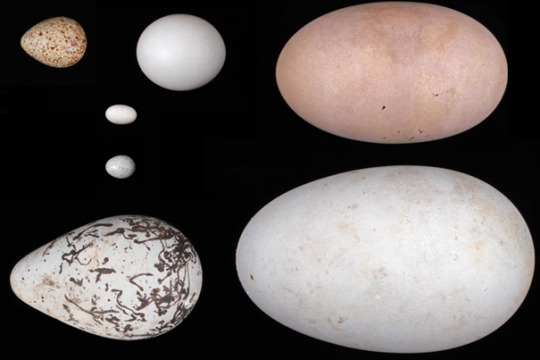
What is an amniotic egg? It is an egg that is adapted to retain water without needing to be in water. In other words, an egg with a shell (either soft or hard). Of course, just like living on land required more than just legs, amniotes (animals that produce an amnion) needed more than just a protective shell.
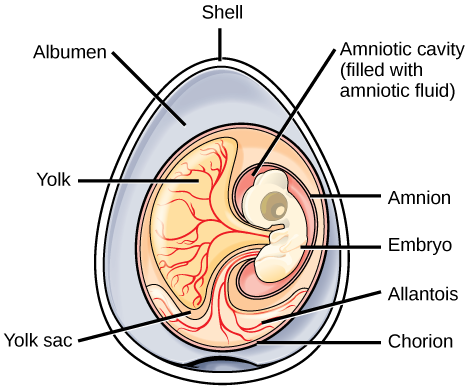
Fish and amphibians only have one inner membrane, the embryonic membrane. Amniotes have four: the yolk sac which surround the yolk, the amnion which surrounds and cushions the embryo, the allantois which helps with gas exchange and waste removal (becomes the umbilical cord in mammals) and the chorion which is the outer most membrane and surrounds everything.
Amniotes also lack otic notches because they are fully terrestrial (yes, some are secondarily aquatic but that is for a later discussion). Instead, they have extra holes in their heads for muscle attachments and to lighten the weight as amniotes can grow quite large.
Anapsids are the ancestral condition. These early amniotes lacked the temporal fenestrae that the other two groups have. Turtles are anapsids.
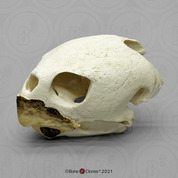

Synapsids have one set of lateral temporal fenestrae. Synapsids include mammals and their ancestors like us and Dimetrodon.

Diapsids have two sets of temporal fenestrae in their skulls. These include reptiles, dinosaurs and birds.
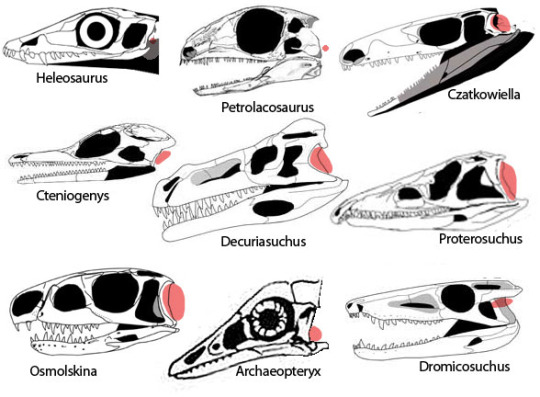
Other traits of amniotes include two pairs of sacral ribs (generally fused to the vertebra and the rest of the sacrum)
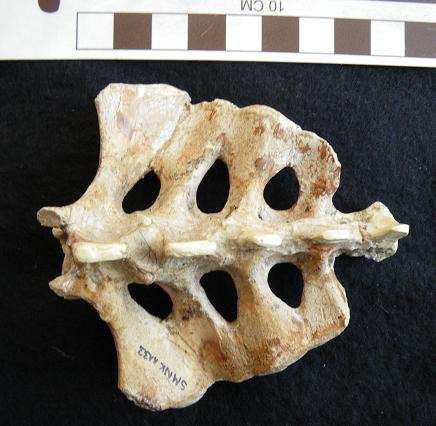
a sternum (some amniotes have lost this secondarily)

and an ankle bone called the astragalus.
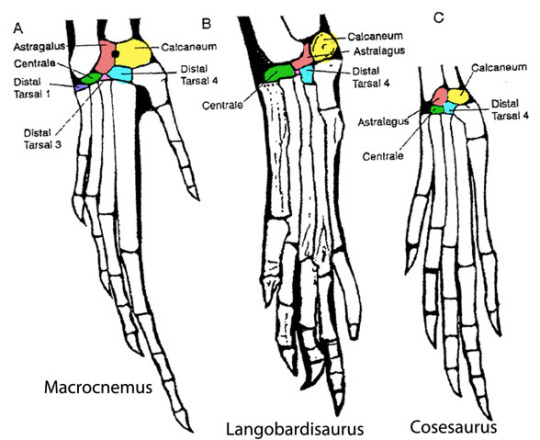
Now that we know a little bit more about amniotes, tune in tomorrow for some trivia! Fossilize you later!

#paleontology#fossils#fun facts#amniotes#eggs#reptiles#mammals#birds#dinosaur#anapsids#synapsids#diapsids#comparative anatomy#vertebrates#vertebrate anatomy
39 notes
·
View notes
Text
Crystal Palace Field Trip Part 1: Walking With Victorian Monsters
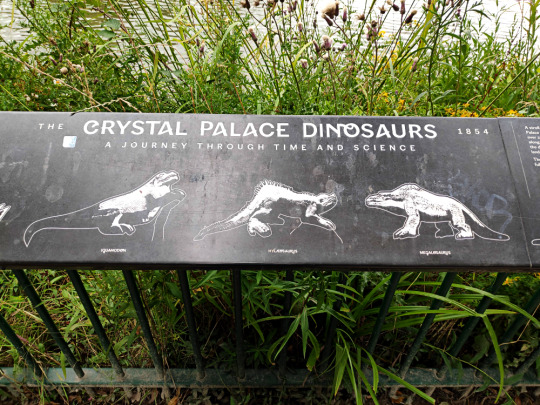
The Crystal Palace Dinosaurs take their name from the original Crystal Palace, a glass-paned exhibition building originally constructed for a World's Fair in Hyde Park in 1851.
In 1854 the structure was relocated 14km (~9 miles) south to the newly-created Crystal Palace Park, and a collection of over 30 life-sized statues of prehistoric animals were commissioned to accompany the reopening – creating a sort of Victorian dinosaur theme park – sculpted by Benjamin Waterhouse Hawkins with consultation from paleontologist Sir Richard Owen.
The Palace building itself burned down completely in 1936, and today only the ruins of its terraces remain in the northeast of the park grounds.

The Crystal Palace building then and now Left image circa 1854 (public domain) Right image circa 2011 by Mark Ahsmann (CC BY-SA 3.0)
Six sphinx statues based on the Great Sphinx of Tanis also survive up among the Palace ruins, flanking some of the terrace staircases. They fell into serious disrepair during the latter half of the 20th century, but in 2017 they all finally got some much-needed preservation work, repairing them and restoring their original Victorian red paint jobs.

———
…But let's get to what we're really here for. Dinosaurs! (…And assorted other prehistoric beasties!)
The "Dinosaur Court" down in the south end of the park still remains to this day, displayed across several islands in a man-made lake. Over the decades they've been through multiple cycles of neglect and renovation, and are currently cared for by the London Borough of Bromley (Crystal Palace Park Trust are due to take over custodial duties in September 2023), with promotion and fundraising assistance from organizations like Historic England and the Friends of the Crystal Palace Dinosaurs charity.
Just about 170 years old now, the Crystal Palace Dinosaurs represent fifteen different types of fossil creatures known to 1850s Victorian science, with only three actual dinosaur species featured. Although often derided for being outdated and very inaccurate by modern standards, they were actually incredibly good efforts at the time, especially taking into account that the field of paleontology was still in its very early days.
They also just have a lot of charm, with toothy grins and surprisingly dynamic poses.
Unfortunately on the day I visited in early August 2023 most of the statues were heavily obscured by plant growth, both on their islands and on the sides of the paths they can usually be viewed from. Since I'd seen images from about a month ago showing things being less overgrown, this was probably just some unlucky timing on my part coinciding with some explosive summer foliage growth.
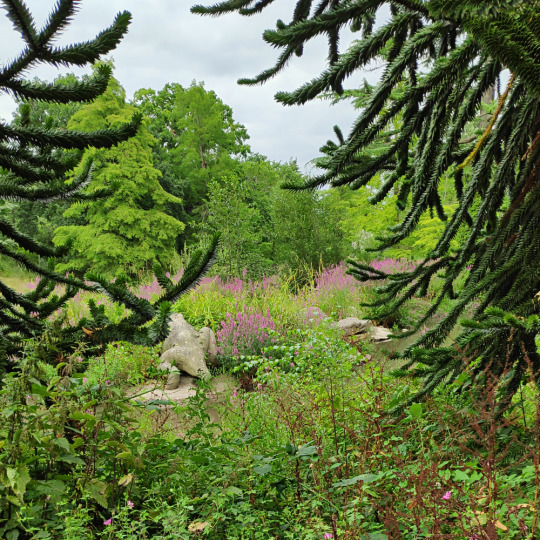
The first island on the trail features a few Permian and Triassic animals which were only known from fragmentary remains in the 1850s. These "labyrinthodonts" were recognized as having similarities to both amphibians and reptiles, and so were depicted with boxy toothy jaws, warty skin, stumpy tails, and long frog-like back legs.
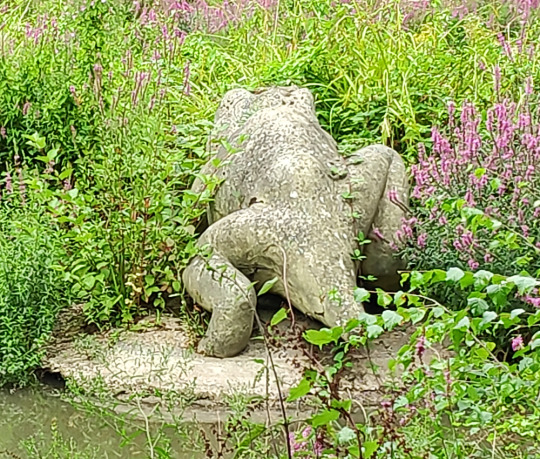
Today we'd call these particular animals temnospondyl amphibians, specifically Mastodonsaurus, and we know they were actually shaped more like giant salamanders with longer flatter crocodilian-like jaws, smaller legs, and long paddle-like tails.

———

Somewhere in the foliage beyond this specific "labyrinthodont" there was also supposed to be a pair of dicynodonts, but I couldn't see much of them at all and didn't manage to get a remotely visible photograph.
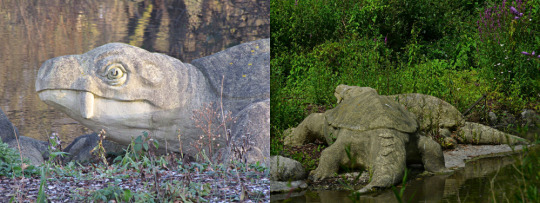
Crystal Palace Dicynodon when much less overgrown Left photo by London looks (CC BY 2.0) Right photo by Loz Pycock (CC BY SA 2.0)
These Dicynodon are depicted as looking like sabre-toothed turtles complete with shells. That was fairly speculative even for the time, but considering only their weird turtle-beaked-and-walrus-tusked skulls were known it was probably the best guess Hawkins and Owen had. Today we know these animals were actually synapsids related to modern mammals, but Victorian understanding considered them to be a type of reptile.
Modern reconstructions of dicynodonts have a slightly different face shape, along with squat pig-like bodies and semi-sprawling limbs. They may have had fur, but currently the only known actual skin impressions from the genus Lystrosaurus show leathery bumpy hairless skin.

———
Next time: the Jurassic and Cretaceous sculptures!
#field trip!#crystal palace dinosaurs#retrosaurs#i love them your honor#crystal palace park#crystal palace#labyrinthodont#temnospondyl#mastodonsaurus#dicynodont#dicynodon#synapsid#paleontology#vintage paleoart#art
387 notes
·
View notes
Text
RainWing Names - Letter A
Abacaxi (A large, sweet pineapple that grows in Brazil.) Abiu (A fruit/fruit tree from the Amazonian region of South America.) Abundance (An extremely large quantity of something.) Acacia (A genus of trees.) Açaí (A type of berry, resembles blueberries.) Achiote (A spice that is also often used to add yellow color to food. Also known as Annato.) Ackee (A type of fruit native to West Africa.) Arco Iris (Spanish for 'rainbow'.) Admirable / Admiration / Admire (To regard something or one with respect and approval, or be deserving of it.) Adore / Adorable (To love or respect deeply, or be deserving of it.) Adventure / Adventurous (An unusual or exciting experience or activity; someone willing to take risks or to try out new methods, ideas, or experiences.) Aegithina (A type of bird also known as the Iota.) Aesthetic (A particular theory or conception of beauty or art.) Affectionate (A gentle feeling of fondness or liking.) Agouti (A type of rodent.) Aguaje (A type of palm tree.) Airy (Giving an impression of being unconcerned or not serious, typically about something taken seriously by others.) Aka (Japanese for 'red'.) Akebi (A type of fruit native to Japan, China and Korea.) Aki (Japanese for 'autumn', or another name for the Ackee.) Alder (A type of tree from the birch family with toothed leaves.) Alligator (A large semi-aquatic reptile.) Allium (A type of flowering plant. Often purple, but can come in many other colors.) Allure / Alluring (The quality of being powerfully and mysteriously attractive or fascinating.) Almond (The seed of the almond tree.) Aloe / Aloe Vera (A type of succulent that primarily grows in arid climates. Also good for a SandWing hybrid.) Alyssum (A type of flower.) Amaranth (A type of flower.) Amarillo (Spanish for 'yellow'.) Amaryllis (A type of poisonous flower.) Amazing (Causing great surprise or wonder; astonishing or startlingly impressive.) Amazon (As in the Amazon Rainforest, the most famous rainforest.) Ambition / Ambitious (A strong desire to achieve or do something, or showing that desire.) Ame (Japanese for 'rain'.) Amla (Also known as the Indiana Gooseberry, a type of fruit.) Ammolite (An opal-like gemstone made of the fossilized shells of ammonites.) Amusement (The state or experience of finding something funny or entertaining.) Anar (Another name for the Pomegranate.) Anaconda (The largest snake species in the world. They are great swimmers, so this could also be good for a SeaWing hybrid.) Ananas (The plant genus that contains the pineapple.) Angel Aura Quartz (Quartz that undergoes extreme heat and is then coated with a special blend of metals such as Platinum, Gold, and Silver.) Angelic (To be beautiful, innocent, pure, or kind.) Anger / Angry (A strong feeling of annoyance, displeasure, or hostility.) Anise (A flowering plant. It's seeds are used as a spice.) Annona (Also known as the soursop, or custard apple.) Anole (A type of lizard.) Ant (Insects that live in colonies.) Anteater (Toothless insect eating mammals with long tongues.) Ānuenue (Hawaiian for 'rainbow'.) Anura (The order frogs belong to.)
#wings of fire#wings of fire names#wof names#wof#rainwing#rainwing names#a names#names in other languages#fruit names#plant names#flower names#gemstone names#color names#personality describing names#rodent names#reptile names#amphibian names#mammal names#bird names#insect names#red color names#adjective names#location names#weather names
19 notes
·
View notes
Text
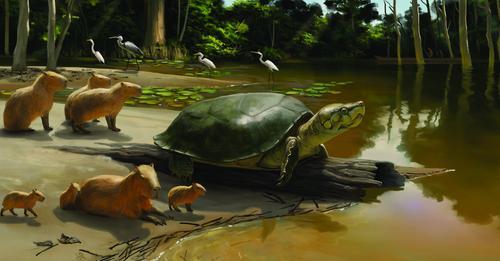
Newly discovered fossil of giant turtle is named after Stephen King novel character
Senckenberg Research Institute and Natural History Museum
An international research team led by Dr. Gabriel S. Ferreira from the Senckenberg Center for Human Evolution and Paleoenvironment at the University of Tübingen has described a new species of giant turtle from the late Pleistocene. Peltocephalus maturin is between 40,000 and 9,000 years old and comes from the Brazilian Amazon. With a shell length of about 180 centimeters, the species is one of the largest known freshwater turtles in the world. The armored reptile was named after the giant turtle "Maturin," a fictional character created by best-selling author Stephen King. With a maximum shell length of 140 centimeters, the Asian narrow-headed softshell turtle (Chitra chitra) together with the approximately 110-centimeter-long South American river turtle (Podocnemis expansa) is one of the largest freshwater turtles alive today...
Read more: https://phys.org/news/2024-03-newly-fossil-giant-turtle-stephen.html
49 notes
·
View notes
Note
(Resending it but fixing up what I FORGOT to type 😭😭😭)
Haii I was wondering if u could make a regressor!Syzoth(reptile) from mortal kombat 1 moodboard? (and maybe some headcanons if your able) please and thank uuuu -🐯
Sure thing! I hope you enjoy! Thank you for the request. :)
💚.。.:*:.。.🐍.。.:*:.。.🧃.。.:*:.。.🕯

Regressor! Syzoth agere moodboard for anon! (*’▽’*)♪

🐍Headcanons🐍
🌿Syzoth will often prefer more chew toys, teethers, and soft toys he can put in his mouth and chew on when in his reptilian form. When in human form he'll wear chewelry.
💚When excited, Syzoth will run around with a toy in his mouth often like an enthusiastic puppy! :3 It helps get some of that energy out.
🧃Ashrah and Baraka would definitely watch over the little one. Syzoth excitedly running up to them with a new game to play.
🌿One of Syzoth's favorite little games to play is "digging for fossils". Whether that be the little kits found in shops or a homemade one that one of his caregivers makes, hiding trinkets in dirt for Syzoth to find.
💚Syzoth also like to play with sand! Making sand castles, hiding/finding shells, it excites him! You can find him playing in a little sand box frequently with small toys scattered in the sand all around him.
🧃It's easy to tucker this little one out. On very low energy days, Syzoth grabs his favorite blanket (the perfect one for warmth), dresses in a large onesie, takes a plush friend and brings it with him to bed, curling up around himself to keep warm. The little guy is out like a light! 💤

Moodboard made with Picsart! ☆
Click moodboard for better quality! <3
Please let me know if there are any typos or mistakes! :)
Requests: CLOSED!
Dividers by: @attxnt
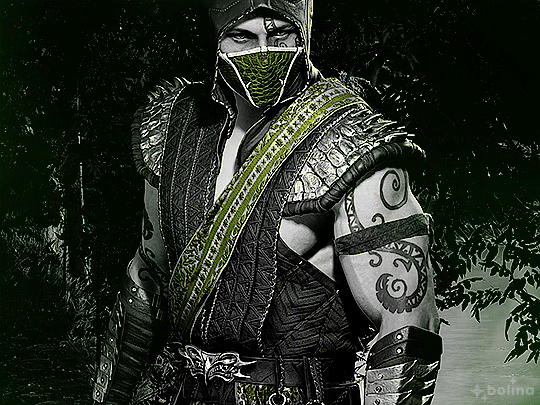


#safe agere#age regression#agere#agere moodboard#agere headcanons#fandom agere#mortal kombat agere#moodboard#headcanons#requests
34 notes
·
View notes
Text
Vertebrates 2/24
today in verts we talked about turtles. apparently, turtles have a lot going on that make them super freaky when it comes to their sister taxa.
Lets start with this question: What exactly ARE turtles?
Order Testundies
Sauropsida
Only 361 alive species across 14 families
Instantly recognizeable because of shell
What is so weird about them?
Turtles have anapsid skulls, and are the only amniotes (vertebrates that lay amniotic eggs) with this condition
What is an anapsid skull?
Anapsid skull is a type of Temporal Fenestration.
Temporal fenestrae are openings in the skull that are behind the eyes which allow movement of the lower jaw.
Anapsid means no fenestra, so the only opening are the orbits (eye holes) and nostrils. (turtles)
Synapsid means single fenestra, which is the lower fenestra. (this is what humans have, including mammals and mammal like reptiles)
Diapsid means two fenestrae, which are upper and lower. (lepidosaurs and archosaurs [lizards/snakes, crocodiles/dinosaurs/birds, respectively])
The big question with turtles anapsid skulls is: were they always this way, or did they lose their synapsid/diapsid condition?
The answer comes from the fossil record. In the past we can see that the synapsid condition appears in turtles once in the synapsid lineage, and the diapsid condition appears once in the sauropsid lineage. This proves that turtles evolved to have the anapsid condition in their skull, making it a secondary condition.
2. Modern turtles lack teeth
Jaws of turtles are surrounded by a hard keratinous sheath. Keratin is the same thing our fingernails are made of, but this is a much thicker and denser makeup of it. It has a very sharp beaklike shape that is good for cutting plant and animal material. This is good, because most turtles are omnivores or carnivores.
There are some turtles that are herbivores, but these are usually stenophagous (specific diet) and only eat a certain food in general.
3. Modern turtles are divided into two groups
Cryptodira
262/361 species belong here
head retracts as a vertical S-bend
known as "S-necked" turtles
found in fresh water, marine, and terrestrial
Pleurodira
99/361 species belong here
head retracts by bending horizontally into shell
known as "side-necked" turtles
All freshwater
4. Turtle Shells
Formed by 3 elements
Endoskeleton (spine, ribs, clavical)
Exoskeleton (dermis)
Epidermis (keratinous scutes)
Two halves of shell are:
carapace (top)
plastron (bottom)
The carapace is covered in scutes, which are the individual outlined shapes on top. Under the carapace is bone, dermal and endochondral. Dermal bone is the lower layer and endochondral is the upper layer.
Now lets talk about the types of shells:
Hinged shell
Hinge in the middle that allows the plastron to close the front and back opening of the shell
OR
Double hinge on either end
Weird shells
Lack keratinous scutes and bony plates are reduced
OR
Lack keratinous scutes and the bony plates are replaced by thousands of dermal bone
Evidence of turtles date back to the triassic period
5. How do turtles breathe?
Before getting into this, it is important to note that during development, turtles ribs fuse to their shell, which is good because it reinforces their shell, but it also changes how they breathe in comparison to other amniotes.
Amniotes use a process called costal ventilation, which is where when the lungs expand with air, the ribcage moves with it, and then when the lungs exhale, the ribcage goes back to normal. Because turtles cannot move their fused ribcage, they had to adapt a new way of breathing.
Instead of moving their lungs, turtles move their guts!
when the turtle inhales, the lungs expand. a few muscles and membranes surrounding the guts stretch and allow the lungs to push their gut downward
when the turtle exhales, the muscles and membranes push the guts back up towards the deflating lungs
This causes problems for many turtles functions.
when a turtle is fully retracted inside of its shell, it cannot breathe and must hold its breath
Sea turtles cannot breathe when they walk. they must walk, then take a break to breathe
Most turtles can breathe when they walk due to their diagonal gait. They walk with their left back foot and right front foot, and then right back foot and left front foot.
Aquatic turtles must come up for air, which makes them vulnerable to predators. Luckily, they can hold their breath for a very long time.
There is another way for turtles to breathe which is honestly pretty funny. I'm being completely serious when I tell you, some of them can breathe through their buttholes. They literally open their butthole over and over and pump water in and out and are able to diffuse oxygen from the water. This is really good for them to not have to surface, especially for turtles who get trapped under ice in colder months.
6. Turtle reproduction!
Lay on average 4-5 eggs, or even up to 100 eggs!
Almost no parental care, layed egg and then you are on your own!
Temperature dependent sex determination (TSD):
temperature determines sex of turtle. (Humans are the organism with gender, everything else is sorted by sex)
changes of even 3-4 degrees can determine sex
Lower temps mean males while higher temps mean females
Challenges of reproduction:
Few eggs and slow maturity mean turtles do not reproduce fast enough to combat endangerment
Pet trading, food collection, medicine, habitat destruction, and pollution all affect turtles
Global warming effects TSD and creates a disproportionate ratio of sexes which affects future reproduction as well
Over half of the 361 species are endangered
In conclusion, turtles are funky. We need to protect them to ensure they stay on our earth!
3 notes
·
View notes
Photo

Trionyx Fossil Turtle Shell – Eocene Barton Beds Hampshire UK, Genuine Softshell Turtle Fossil
An exceptional and rare Trionyx fossil turtle shell discovered in the Barton Formation (Barton Beds), dating to the Eocene Epoch (~40 million years ago). This impressive specimen was collected by our dedicated fossil team members Alister and Alison on 08 June 2024 from Barton-on-Sea, Hampshire, and has been professionally cleaned, prepped, and treated by Alison.
Trionyx is a genus of extinct softshell turtles within the family Trionychidae, known for their leathery shells and aquatic adaptations. Their fossils are rarely found complete, making this partial shell specimen a significant and highly desirable piece.
Fossil Type: Turtle Shell (Reptile – Trionychidae)
Genus: Trionyx
Geological Age: Eocene – Bartonian Stage
Formation: Barton Formation (Barton Clay)
Depositional Environment: The Barton Beds were laid down in a shallow, subtropical marine to marginal marine environment with estuarine influence. These coastal systems were rich in life and conducive to the preservation of both marine and nearshore vertebrates.
Morphological Features:
Flattened carapace (shell) fragments typical of softshell turtles
Possible preserved margin or plastron elements
Mineralised bone texture visible under close inspection
Notable:
Rare Eocene turtle fossil from a classic British fossil site
Discovered and prepared by our own team with full provenance
Ideal for collectors, display, or educational use
The exact specimen shown is the one you will receive
Authenticity: All of our fossils are 100% genuine natural specimens and come with a Certificate of Authenticity. The scale cube in the image equals 1cm – please refer to the photo for full sizing.
This Trionyx fossil turtle shell from the Eocene of Barton-on-Sea offers a rare and scientifically valuable glimpse into the reptilian life of Britain’s ancient coastal environments. A standout piece for collectors and fossil enthusiasts.
#Trionyx fossil#fossil turtle shell#Barton-on-Sea fossil#Eocene turtle fossil#Barton Formation fossil#Hampshire fossil turtle#softshell turtle fossil#Trionychidae fossil#fossil reptile shell#UK Eocene fossil#genuine fossil turtle#collector turtle fossil#fossil reptile UK
0 notes
Text

Act like Megalochelys atlas and smile, because it’s Fossil Friday! One of the largest known land turtles, scientists think this massive reptile could reach heights of 5.9 ft (1.8 m)—tall enough to look a grown human in the eye. This specimen’s shell measures some 7.4 ft (2.3 m) long and in life, it may have weighed more than 2,000 lbs (907 kg). Megalochelys lived during the Late Pliocene about 2 million years ago. The fossil on display in the Museum’s Hall of Vertebrate Origins was found in 1922 in Chandigarh, India.
Photo: © AMNH
#science#amnh#museum#fossil#nature#natural history#animals#paleontology#turtle#herpetology#did you know#fact of the day#pliocene#fossil friday#cool animals#turtles#smile#ancient animals#reptiles
2K notes
·
View notes
Text
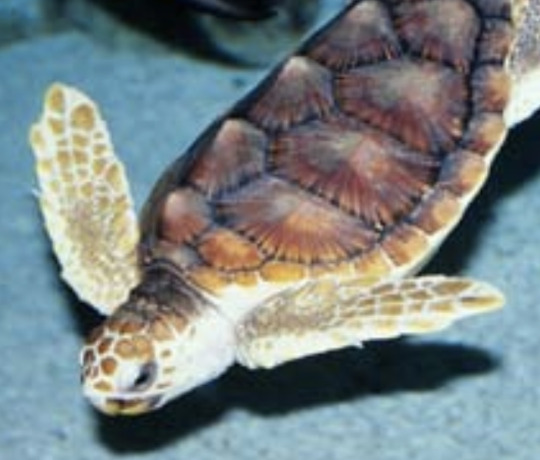

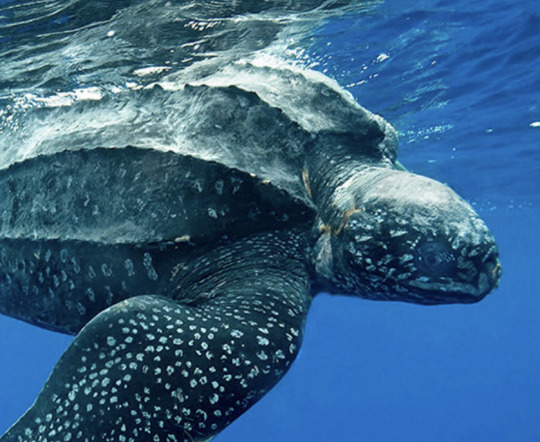
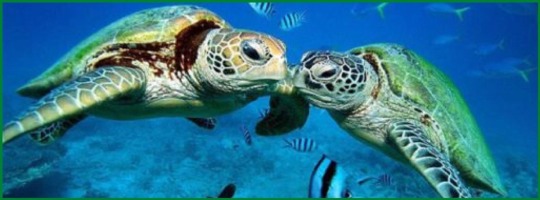
Image 1 : Loggerhead - Caretta caretta
Fun Fact : Loggerheads are the oldest reptile species which started to live in the sea instead of land. The oldest fossil of them that is known is from 150 million years ago ! (*´◒`*)
Image 2 : Kemp's ridley - Lepidochelys kempi
Fun Fact :The Kemps ridley sea turtle is the smallest and most endangered sea turtle species.( omg the nose looks like a heart !) (*^o^*)
Image 3 : Leatherback - Dermochelys coriacea
Fun Fact : Leatherbacks are the only species of sea turtle that don't have scales and a hard shell. (๑˃̵ᴗ˂̵)
September 29 , 2023 (^_−)−☆
Happy Birthday, @lonely99sworld ! 🫶
#marine biology#fun facts#ocean#marine science#ocean life#salt water#scientific names#endangered species#aqua life#meow#sea turtle#leatherback turtle#loggerhead
22 notes
·
View notes
Text
Round 2 - Chordata - Dipnoi




(Sources - 1, 2, 3, 4)
Dipnoi is a class of Sarcopterygiian fish commonly called “lungfish”. While widely distributed since the Early Devonian, today only 6 species remain. They are the closest living relatives to tetrapods (amphibians, reptiles, and mammals).
Like other Sarcopterygiians, lungfish have lobed, bony fins and a well-developed internal skeleton. True to their name, they have a highly specialized respiratory system which includes lungs, subdivided into numerous smaller air sacs. Most extant lungfish species have two lungs, with the exception of the Australian Lungfish (Neoceratodus forsteri), which has only one. The Australian Lungfish can breathe through its gills without needing air from its lung, but in all other species the gills are too atrophied to allow for adequate gas exchange. Lungfish have unique dentition, bearing fan-shaped tooth plates called odontodes, which are used to crush hard shelled organisms. Some groups have ridges on these tooth plates that form occluding blades. They are omnivorous, feeding on fish, insects, crustaceans, worms, mollusks, amphibians, and plant matter. African and South American Lungfish are capable of surviving seasonal drying-out of their habitats by burrowing into mud and estivating throughout the dry season.

(own work)
Propaganda under the cut:
The Australian Lungfish has existed in Australia for at least 100 million years, making it a true living fossil and one of the oldest living vertebrate genera on the planet. It is the most primitive surviving member of the ancient Dipnoi lineages.
The Marbled Lungfish's (Protopterus aethiopicus) genome contains 133 billion base pairs, making it the largest known genome of any vertebrate. The only organisms known to have more base pairs are the amoeboid Polychaos dubium and the flowering plant Paris japonica at 670 billion (possibly) and 150 billion, respectively.
The Spotted Lungfish (Protopterus dolloi) can aestivate on land by surrounding itself in a layer of dried mucus.
An Australian Lungfish named “Granddad” at the Shedd Aquarium in Chicago lived to be 109 years old, before he had to be euthanized due to an age-related decline in health. The current oldest Australian Lungfish is now “Methuselah”, who lives at the California Academy of Sciences, and is around 100 years old. Methuselah has been described as "mellow" by her keeper. She is also noted to like belly rubs, back rubs, and fresh figs.
Australian Lungfish are one of the cutest animals on the planet and I want a life-sized plushie/body pillow of one
86 notes
·
View notes
Text
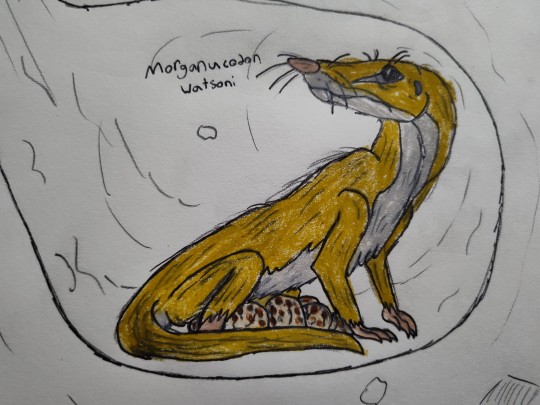
Happy Easter everyone! While you may never see a bunny laying colorful eggs, it may come as a surprise that once upon a time, egg-laying mammals were the norm. In fact, it wasn't until as recently as about 140 Mya that mammals started giving live birth. In fact some mammals, like the echidna and platypus, still lay eggs today.
Morganucodon (Glamorgan Tooth), was a very small, early mammaliform that lived from the late Triassic to the middle Jurassic (~205-163 Mya). This primitive mammal's skull was only about 2-3 cm in length, and it had the appearance of a mouse or shrew. It is thought to have been a burrower, and its eggs were probably small and leathery, much like the eggs of modern monotremes.
The amniotic egg was an important milestone in the evolution of life. While amphibians still lay their jelly like spawn in the water, later tetrapods would adapt a more advanced egg with a protective shell. This would allow these animals to live further inland, without needing to rely on the water so much. We think these amniotes diverged during the Carboniferous about 312 Mya, but since eggs typically don't fossilize well, our earliest fossil evidence of eggs don't appear until about 195 Mya, a group of fossilized eggs laid by stem Sauropod dinosaurs in the early Jurassic.
The amniotes would split into two major groups, the Synapsids and Sauropsids. The ancestors of today's mammals and reptiles respectively.
#happy easter#paleoart#paleontology#evolution#mammals#morganucodon#eggs#easter#easter egg#zoology#amniote
10 notes
·
View notes